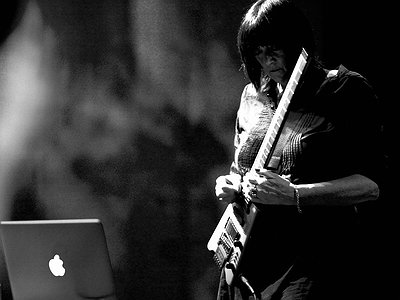Where do ideas come from, what do you start with and how do you go about shaping these ideas?
The creative process can vary - ideas can be triggered by a word, a phrase that needs a sound to make it physically resonate, or just one nuance within a sound be it a drum beat, strings, anything.
I don’t ‘write’ music. I create on the fly, intuitively, placing and shaping sounds, listening for the next sound that suggests itself as I go along. From that I either hear a place for a voice (not necessarily singing) or not.
All the time I’m working I want to be consumed by the music, the minute I loose that feeling or the excitement of what I ‘hear’ as the next potential step it’s time to take a break. I don’t like overworking pieces.
With more and more musicians creating than ever and more and more of these creations being released, what does this mean for you as an artist in terms of originality?
I never think about originality when I work, it’s not on my ‘to do’ list.
There’s a lot of noise out there, some of it good, some too reliant on what’s already been done to death - I suppose to some people that may be ’new’ - I’ve been around a long time so I feel frustrated when I hear lazy appropriation that doesn’t take the original idea in a different and interesting direction.
How strictly do you separate improvising and composing?
They are part and parcel of the same thing for me.
How do you see the relationship between sound, space and composition and what are some of your strategies and approaches of working with them?
Feeling my way through. Sometimes a relentless sound can work, other times there needs to be space for the piece to breath and settle with you. It’s recognising those moments that is important.
Playing live is very different to working in the studio. PA physicality volume, audience, response and feed off it.
What's your perspective on the relationship between music and other forms of art – painting, video art and cinema, for example – and for you and your work, how does music relate to other senses than hearing alone?
I’ve always perceived music as physically and emotionally evocative and is my preferred mode of expression. Visuals are amazing but can’t deliver the direct physical effect that sound can. Even when you have a great film or video with a super sound system and sound track, the fact that someone else has presented visuals to represent the sound and/or vice versa, the space you can inhabit within the work has limitations. Music allows you more freedom with no prescribed entry points.
What's your view on the role and function of music as well as the (e.g. political/social/creative) tasks of artists today - and how do you try to meet these goals in your work?
Music and the arts are essential to the soul. The task of artists today is as always, to challenge and break through boundaries. That is ever-more important at times like this when we face political and social crises.
Listening is also an active, rather than just a passive process. How do you see the role of the listener in the musical communication process?
Essential. My music is all about a dialogue, communication, so the listener is an important part of it.
Reaching audiences usually involves reaching out to the press and possibly working with a PR company. What's your perspective on the promo system? In which way do music journalism and PR companies change the way music is perceived by the public?
I’ve never been comfortable ‘selling’ myself. I prefer for someone to do it for me. Having said that there’s a lot to do with providing YouTube and streaming clips and so on - which makes for a more interesting way to promote music.
Do you have a musical vision that you haven't been able to realise for technical or financial reasons – or an idea of what music itself could be beyond its current form?
I wouldn’t tell you.



